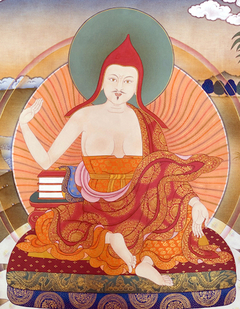Essence of Prāsaṅgika Madhyamaka
Conveying the Essence of the Middle Way of Consequence
by Jamyang Khyentse Chökyi Lodrö
Noble and reverend Guru Mañjughoṣa,
Glorious Candrakīrti, I bow before you.
Of the various discerning explanations of your intent
offered by scholars here in Tibet,
the direct elucidation of the vision of
The Introduction to the Middle Way[1]
in the tradition of the victorious Lobzang[2]
uses reasoning to determine how phenomena
are beyond arising and devoid of true existence.
In this, a key point is that the so-called
self of the individual
is merely a mental projection,
and apprehension of something autonomous
upon the object is what is negated.
It is very important to be certain about this
and to determine the absence of self.
Unless you realize the absence of phenomenal identity,
in particular, through this mode of apprehension,
you will be unable to subdue the enemy, afflictions.
When employing reasoning to determine the nature of all things,
once you have put a stop to your clinging to them as existent,
generate certainty concerning emptiness and absence of existence,
because a lack of certainty will lead to mental blankness.
When the sequential extremes
are eliminated all at once,
then, in the unity of emptiness and interdependence,
as you realize how cause and effect dawn as emptiness
and emptiness dawns as cause and effect,
in perfect unity beyond conflict,
you will understand the profound meaning of interdependence,
which is the secret treasury of the Omniscient One.
Jampal Gawé Gocha wrote this in Darjeeling on the 28th day of Saga Dawa.[3] May virtue and excellence abound!
| Translated by Adam Pearcey with the generous support of the Khyentse Foundation and Tertön Sogyal Trust, 2021.
Bibliography
Tibetan Edition
'jam dbyangs chos kyi blo gros. "dbu ma thal 'gyur ba'i don snying nges par brjod pa/" in ’jam dbyangs chos kyi blo gros kyi gsung ’bum. 12 vols. Bir: Khyentse Labrang, 2012. W1KG12986 Vol. 8: 575–576
Version: 1.0-20210509
